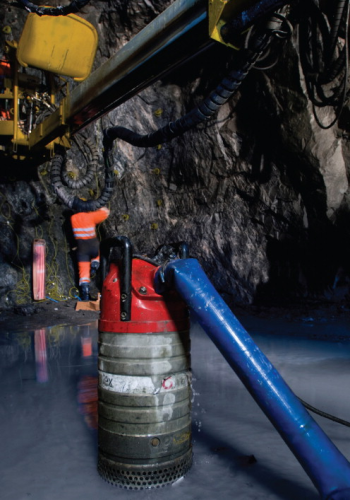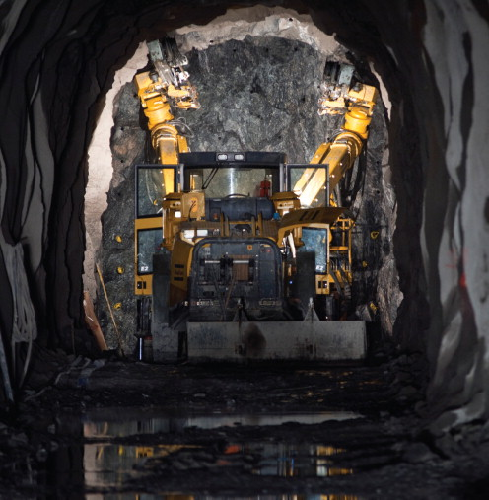

A pdf version of this article is available on the right-hand side under 'Downloads'.
The Baltic Sea region could be one of the fastest developing regions during the next few decades. By 2030, Stockholm is expected to have 25% more inhabitants than today, and these people require homes in one of the most densely populated areas in northern Europe, an area divided down the middle by Lake Mälaren and the Baltic Sea. In Stockholm, this growth is shown by the large quantity of construction projects currently on the go. Modern technology is transforming the city making it possible to quickly receive and integrate new inhabitants.
One of the things making it possible to erect 3,000 new dwellings within the space of a few years is the installation of seven submersible pumps deep in the bedrock below south Stockholm. These pumps are designed to keep a high voltage cable tunnel dry.
Tunnel construction
”We are working on five parallel fronts at the moment, enabling us to maintain a pace of around 80 to 100 m per week,” says Peter Ahlgren of Oden Anläggningsentreprenad, blasting supervisor for the new high voltage cable tunnel. The work started in January 2007 and tunnel blasting is scheduled for completion by April 2010 with a further year before the tunnel is fully operational.
The Skanstull-Solberga cable dry tunnel is one of a number of major construction projects in progress around Stockholm and its importance as a part of the city's development is considerable. 10 km of 220 kV high voltage cable cutting straight through residential area will now be replaced with cables laid through the new tunnel. This in turn will provide sufficient land near the city for some 3,000 new homes.
The total length of the main tunnel is 6.3 km, with an additional 800 m of approach tunnels. The depth varies from 30 to 60 m. Two of the five tunnel fronts are blasted from the middle outwards and accessed via a subterranean transport tunnel. Work on both fronts takes place in turn, blasting on one while clearing away the rubble on the other. On the east front a wheeled loader is fully occupied with lifting away about 80 m3 of rock that is taken out of the tunnel to various stone crushers by lorry. On the west front, the rock is granite with seams of diabase, a very hard stone, which means that wear on the drill bits is harsh and the drills need large quantities of cooling water.
Wear and tear
Reliable pumps are needed to keep operations going, having to operate continuously to keep the water out, and a breakdown would have immediate and serious consequences.
”It is very important for the pumps to work properly if we are to keep up to the schedule,” says Ahlgren. “We need to pump out 300 l of water every minute when we're drilling. It's 50 m to the surface, so the pumps need to stand up to a good deal of strain, but so far they have functioned well and we are working according to plan.”
Wear and tear on the pumps is considerable, because the water near the drilling rig is full of drill cuttings which act like a kind of liquid sandpaper which rubs constantly on the internal parts of the pumps.
The company is using two models from its most recent pump series: the Major N-pump which can deliver more than 35 l/s (over 2 m3/min), and the Master H pump which has a delivery head of more than 45 m.
“These are especially strong and hard wearing and built to withstand these kinds of conditions,” sayd Per-Åke Jägren from pump supplier Grindex. “They incorporate an entirely new design, where the abrasives in the water are kept away from the sensitive parts of the pump. Our own tests show that these pumps last three times longer in hard wear and tear situations like these. What we are witnessing here confirms our own tests.”
The water is pumped up from the lowest parts of the tunnel pipe to ground level, 50 m up, with the pumps working in stages using sediment tanks along the way. The water is pumped from the drilling rig to a pump pit, where the water is pumped to the next intermediate station, containing the system's large sediment tank. At this point, most of the remaining drill cuttings are separated from the water and the water pumped on upwards is in large clean. Water samples are taken regularly to ensure that municipal water regulations are obeyed.
Regular servicing
A Grindex Master pump installed closest to the drilling rig is most exposed to the drill cuttings in the water.
“This water is almost like gruel,” says Ahlgren. “The mixture clogs up the system quickly if the plant is not correctly built and dimensioned. Grindex recommend 2000 running hours between services, but we service the pumps every 1500 hours to be on the safe side. In practice this means the shortest service interval for the pump system is two months. However, we carry out a standard daily inspection of the equipment.”
“We've been operating at full speed down here since the end of April and everything has worked properly,” he adds. “We have now come some way into the tunnel construction and are working at maximum speed. It is important to us to be able to maintain this tempo and reliable equipment is essential. Just because the pumps are scarcely noticeable when you pass by them in the tunnel does not make them less important. If one of them were to stop, everything else would stop too.”






